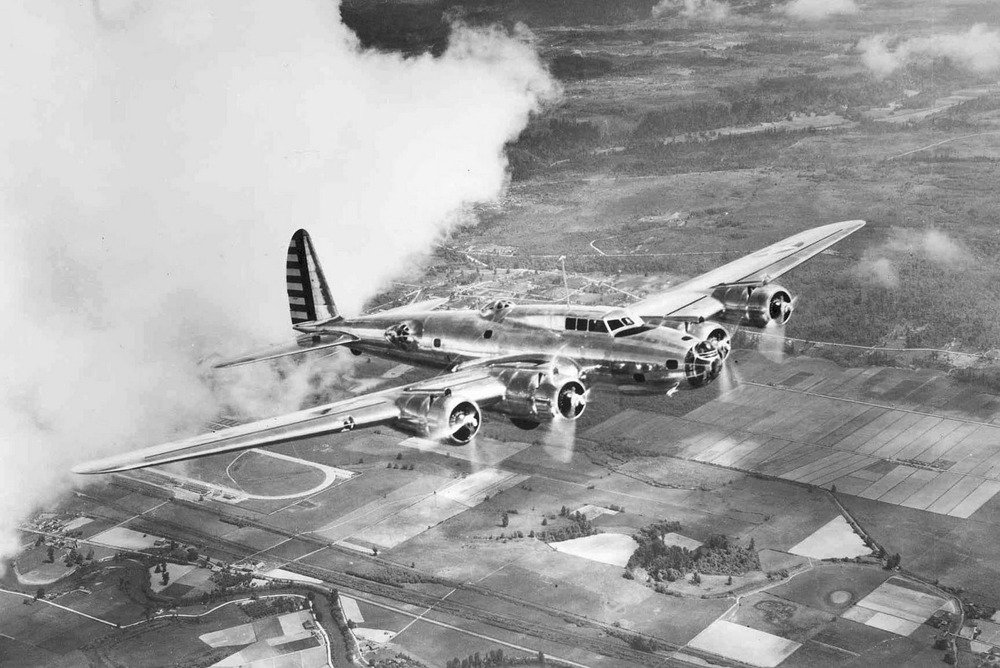History
On August 8, 1934, the US Army Air Corps issued a request for a new long-range bomber to replace the Martin B-10. The service sought an aircraft capable of reaching distant locations such as Hawaii, Panama, and Alaska to support forward-deployed air units. The requirements called for a range of 2,000 miles while carrying a 2,000 lb bomb load, a cruising speed of 200 mph, and a top speed of 250 mph. The contract would be awarded based on a fly-off competition between Boeing and other manufacturers.
To meet these specifications, Boeing developed the Model 299, drawing on features from its experimental XB-15 bomber and the Model 247 airliner. The prototype made its first flight on July 28, 1935, and completed several additional test flights in the months that followed.
During the official evaluation, Boeing’s Model 299 outperformed the Douglas DB-1 and Martin Model 146. However, on October 30, 1935, the prototype crashed during takeoff on a test flight intended to evaluate its climb rate and service ceiling. The aircraft stalled and spun into the ground after the elevator control surface gust lock was mistakenly left engaged, resulting in its destruction. Despite the crash and formal disqualification from the competition, the Army Air Corps was impressed enough with the aircraft’s capabilities that it proceeded to place an order.
Originally, the Army intended to purchase 65 aircraft, but the order was reduced to 13. These were ordered on January 17, 1936, as YB-17s, and were soon redesignated Y1B-17s on November 20, 1936, to reflect their funding source (procured from “F-1” experimental funds rather than standard appropriations). In practice, the YB-17 and Y1B-17 were essentially identical, with no difference or changes.
The Y1B-17 differed from the Model 299 by replacing the original 750 hp Pratt & Whitney R-1690 engines with four 930 hp Wright R-1820-39 Cyclone radial engines. Other changes included a switch to single-oleo main landing gear for easier maintenance, fabric-covered flaps instead of metal, a reduced crew of six, additional fuel capacity, a revised oxygen system, and minor armament changes.
The first Y1B-17 flew on December 2, 1936. Just five days later, one was involved in another accident when two overheated engines failed during landing. The aircraft nosed over on the runway after the brakes collapsed, but no one was seriously injured. Nonetheless, the incident, along with earlier engine overheating and braking issues, led to a Congressional investigation that nearly cancelled the B-17 program. Although the program was not scrapped, the incident did prompt the military to place additional orders for the Douglas B-18 as a short-term alternative.
Despite these setbacks, all 13 Y1B-17s were delivered between January 11 and August 4, 1937. Twelve were assigned to the 2nd Bombardment Group at Langley Field, Virginia, for operational evaluation, while the thirteenth was sent to Wright Field for further testing. These aircraft were eventually redesignated simply as B-17.
The 2nd Bombardment Group played a critical role in validating and refining the B-17. To prevent further mishaps like the Model 299’s crash, the unit pioneered the use of standardized preflight checklists, an innovation that would go on to become standard in aviation.
To showcase the bomber’s potential, the 2nd Bomb Group set several transcontinental speed records in early 1938. On February 15, six B-17s flew from Langley Field to Buenos Aires, Argentina, and returned on February 27 after covering 12,000 miles without any serious incidents. In May 1938, B-17s were dispatched to intercept the Italian ocean liner Rex while it was still 600 miles offshore, demonstrating the bomber’s impressive range. The high-profile interception stirred controversy with the US Navy, which requested that the War Department limit Army aircraft operations to within 100 miles of the coastline.
Later that summer, a B-17 inadvertently flew into a thunderstorm. The aircraft entered an uncontrollable spin within the violent turbulence but was eventually recovered from it. After landing, the airframe was found to have bent wings and popped rivets, proving the ruggedness of the design.
For nearly three years, the B-17s operated without major incident. In October 1940, they were transferred and redeployed to the 19th BG at March Field. Thanks to positive media coverage, the escalation of global conflict, and the aircraft’s proven capabilities, public and military support for the B-17 grew. Subsequent contracts were placed for more advanced variants, including the B-17B, B-17C, and B-17D.
Despite the initial crash of the Model 299 threatening to bankrupt Boeing, the program recovered and ultimately produced one of the most iconic and successful strategic bombers of the Second World War.







